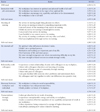Abstract
Methods
Using 44 preliminary items which were developed in a former study, a survey was done with 469 nurses working in 2 city general hospitals. Data were collected from September 19 to October 10, 2014 and were analyzed using statistical packages SPSS 18.0 and AMOS 18.0.
Results
The finalized Nursing Workplace Spirituality instrument consisted of 32 items and 6 sub factors: meaning of nursing, relationship with colleagues, transcendency through nursing service, inner self, interaction between the workplace environments, and harmony between individual and organization. A seven-point Likert scale was employed, and achieving a higher score in a particular factor and sum of all scores indicated high factor and Nursing Workplace Spirituality.
References
1. Maslow AH. The farther reaches of human nature. New York: Viking;1971.
2. Lee WH. Spiritual need assessment, spiritual nursing care. In : Sahmyook University Nursing Department Symposium; 1996.11.25.
3. Yu GC, Seo JH, Kim JI. Conceptual definitions and model of workplace spirituality. Korean Acad Manag. 2010; 18(4):153–199.
4. Kim JI, Kim YD. Construct dimensions & measure for workplace spirituality: Literature review for development of workplace spirituality instrument. In : 2011 Fall Conference of the Korean Academic Association of Business Administration; 2011 November; p. 51–71.
5. Mitroff II, Denton EA. A study of spirituality in the workplace. Sloan Manag Rev. 1999; 40(4):83–92.
6. Covey SR. The leader in me: How schools and parents around the world are inspiring greatness, one child at a time. New York, NY: Franklin Covey Co;2009.
7. Ashmos DP, Duchon D. Spirituality at work: A conceptualization and measure. J Manag Inq. 2000; 9(2):134–145. DOI: 10.1177/105649260092008.
8. Giacalone RA, Jurkiewicz CL. Toward a science of Workplace Spirituality. In RA Giacalone & CL Jurkiewicz (Eds.), Handbook of Workplace Spirituality and Organizational Performance. New York, NY: M. E. Sharpe;2003. p. 3–28.
9. Klenke K. The "S" factor in leadership education, practice and research. J Educ Bus. 2003; 79(1):56–56. DOI: 10.1080/08832320309599089.
10. Thompson CM. The congruent life: Following the inward path of fulfilling work and inspired leadership. San Francisco: Jossey-Bass;2000.
11. Heo KS. Workplace spirituality and its relationship to leadership: A literary review and critique. J Human Resour Manag Res. 2013; 17(1):329–336.
12. Roh SC. The impact of workplace spirituality on organizational effectiveness [Dissertation]. Seoul: Sungkyunkwan University;2013.
13. Milliman J, Czaplewski AJ, Ferguson J. Workplace spirituality and employee work attitudes: An exploratory empirical assessment. J Organ Chang Manag. 2003; 16(4):426–447. DOI: 10.1108/09534810310484172.
14. Koenig HG. Concerns about measuring "spirituality" in research. J Nerv Ment Dis. 2008; 196(5):349–355. DOI: 10.1097/nmd.0b013e31816ff796.
15. Chand P, Koul H. Workplace spirituality, organizational emotional ownership and job satisfaction as moderators in coping with job stress. Int Conf Humanit, Econ Geogr. 2012; 03. 17-18. 225–229.
16. Kumar T, Pragadeeswaran S. Effects of occupational stress on spiritual quotient among executives. Int J Trade, Econ Finance. 2011; 2(4):288–292. DOI: 10.7763/ijtef.2011.v2.119.
17. Miller L, Wickramaratne P, Gameroff MJ, Sage M, Tenke CE, Weissman MM. Religiosity and major depression in adults at high risk: A ten-year prospective study. Am J Psychiatry. 2012; 169(1):89–94. DOI: 10.1176/appi.ajp.2011.10121823.
18. Kazemipour F, Mohd Amin S. The impact of workplace spirituality dimensions on organizational citizenship behaviour among nurses with the mediating effect of affective organizational commitment. J Nurs Manag. 2012; 20:1039–1048. DOI: 10.1111/jonm.12025.
19. DeVellis RF. Scale development: Theory and applications. 3nd ed. California: Sage Publications;2012.
20. Suk JW, Koh MS. Development of preliminary factors for nursing workplace spirituality instrument. Int J Appl Eng Res. 2015; 10(79):294–298.
21. Kang H. Discussions on the suitable interpretation of model fit indices and the strategies to fit model in structural equation modeling. J Korean Data Anal Soc. 2013; 15(2):653–668.
22. Lee HS, Im JH. Structural Equation Modeling with Amos 7.0. Paju: Bubmunsa;2008.
23. Polit DF, Beck CT. The Content Validity Index: Are you sure you know what's being reported? Critique and Recommendations. Res Nurs & Health. 2006; 29:489–497. DOI: 10.1002/nur.20147.
24. Kim KS. Amos 16.0 Analysis structual equation modeling. Seoul: Hannarae;2004.
25. Bagozzi RB, Yi Y. On the evaluation of structural equation models. J Acad Mark Sci. 1988; 16(1):79–94. DOI: 10.1007/bf02723327.
26. Fornell C, Larcker DF. Evaluating structural equation models with unobservable variables and measurement error. J Mark Res. 1981; 18(1):39–50. DOI: 10.2307/3151312.
27. Hair JF, Anderson RE, Tathan RL, Black WC. Multivariate data analysis. 6th ed. NY: MacMillan Publishing Co;2006. p. 1–899.
28. Nunnally JC. Psychometric theory. 2nd ed. NY: McGrawHill Book Co;1978.
29. Kinjersky V, Skrypnek BJ. Measuring the intangible: Development of the spirit at work scale. Acad Manag Proc. 2006(1):A1–A6. DOI: 10.5465/ambpp.2006.22898605.
30. Sheep ML. Nailing down gossamer: A valid measure of the person-organization fit of workplace spirituality. Acad Manag Proc. 2004; 2004(1):B1–B6. DOI: 10.5465/ambpp.2004.13862520.




 PDF
PDF ePub
ePub Citation
Citation Print
Print







 XML Download
XML Download